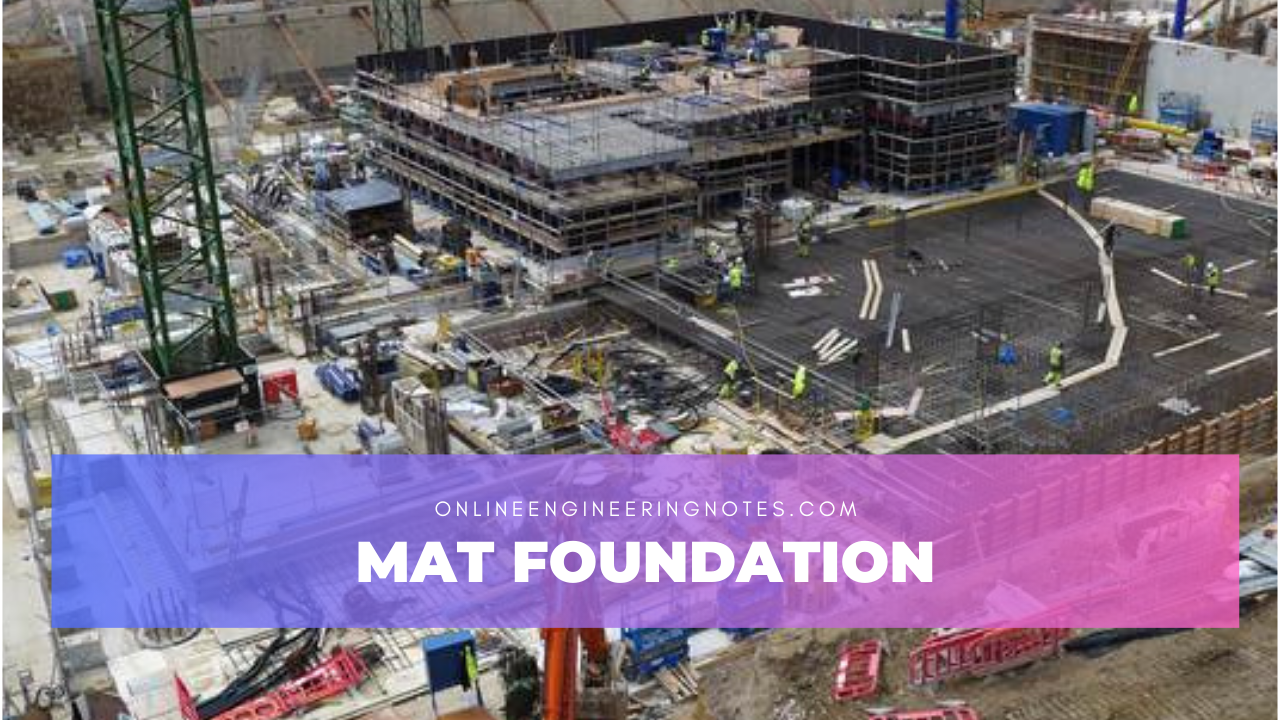1.1 Introduction and types of mat foundation
Mat foundation:
- A large footing which covers the entire area below a structure and supports arrangement of all wall and column.
- Resist the differential settlement.
Types of mat foundation:
1. Flat slab mat
- Single slab of uniform thickness.
- Suitable for closed spaced.
2. Flat slab thickedd under column
- Column is subjected to very heavy load.
3. Rigid frame
- Used to carry extremely heavy load.
4. Piled raft mat
- If soil is highly compressive then this is used.
5. Flat slab with pedestals
- Same as flat slab but pedestals are provided at base.
1.2 Bearing capacity and settlements
1. For cohesive soil
- In cohesive soil net ultimate bearing capacity is determined by skempton’s equation.
qnu = CNc[1+0.2(Df/B)]*[1+0.2(B/L)]
∴ qnu = 5C[1+0.2(Df/B)]*[1+0.2(B/L)]
Let,
Q = Total superimposed load
- Gross pressure (qg) = Q/A
- In term of net ultimate bearing capacity;
∴ qg = qns + γ Df = Q/A – γ Df
2. For cohesion less soil
- Bearing capacity of cohesionless soil depends upon width of footing.
Safe bearing capacity is determined as:
∴ qns = 0.22 N2BRw1 + 0.67 (100+N2)DfRw2
- Safe settlement pressure for a settlement 25 mm is
∴ qns = 17.5 (N-5)Rw1
- Qnp = 22 Rw1 (for 50 mm settlement)
∴ Above equation is applicable for 5 ≤ N ≤50.
1.3 Compensated foundation (Floating foundation)
- When structure in soil is nearly equal to the total excavated soil from ground including weight of water in soil.
i.e Excavated weight = Structural weight
- Settlement of sub soil is prevented.
- Rigid raft foundation is provided when floating foundation is needed.
Diffulties during construction of floating foundation:
- Excavation: Should be done carefully.
- Dewatering: If depth of excavation is below water table dewatering is necessary.
- Critical depth: If soil has low shear strength the limited depth is excavated i.e called as critical depth.
- Bottom heave: Excavation of foundation reduce pressure in below of foundation results in heaving of bottom of excavation.
1.4 Conventional method of analysis
- Determine the line of action of all loads acting on the raft.
- Determine the contact pressure.
a. If e = 0 , q = Q/A
b. If resultant has an ecentricity ex & ey in x & y direction.
Then,
q = (Q/A) ± Q(ex/Iyy)x ± Q(ey/Ixx)y
- Divide the mat into number of beam or strip to analyze each beam separately.
- Draw shear force and bending moment diagram of each strip and calculate qav below the beam.
- Determine modified column load.
Qav = ½ (downward load + upward load)
or, Qav = ½ (Q1 + Q2 + Q3 + qav *B1*x
Modified average soil pressure
qav = Qav/x1* B
Column load modified factor
F = Qav / (Q1+Q2+Q3)
All the column load are multiplied by ‘F’ for the strip.
For strip
FQ1, FQ2 & FQ3
- Draw BMD and SFD for modified column load.
- Find maximum bending moment and shear force.
- Find thickness of slab and reinforcement using BMmax and SFmax.
References:
- Terzaghi, Karl, Peck, R.B & John, Wiley (1969) Soil mechanics in engineering practice, New York.
- Arora , K.R (2008), Soil mechanics and foundation engineering, Delhi: Standard Publisher Distribution.

